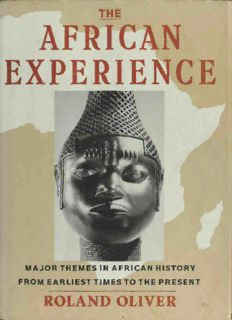
The African experience : [major themes in African history from earliest times to the present] PDF
Preview The African experience : [major themes in African history from earliest times to the present]
This authoritative work covers the entire span of human history across the African continent from the earliest emergence of hominids in eastern and southern Africa to the repeal of the Population Registration Act of 1950 and the lift ing of trade sanctions in 1991. Drawing on forty years of teaching and research, Professor Oliver arranges the book thematically, begin ning with the human colonisation of the differ ent regions of Africa, the origins of food pro duction and the formation and diffusion of African languages. The achievements of ancient Egypt are placed in context with the developments on the rest of the continent, and a wide-ranging discussion of the spread of Judaism, Christianity and Islam gives the reader a valuable insight into an important facet of African culture. Later chapters discuss the nature of slavery in Africa together with the external slave trade and the impact of the caravan trade in precolo nial times. This leads to a perceptive analysis of the strengths and weaknesses of African politi cal systems and why, from the early nineteenth century onward, these systems were unable to withstand the mounting political pressure from abroad and the ensuing colonisation. Professor Oliver presents the colonial partition of Africa as a process of rapid amalgamation of small units through which considerable modernisa tion was achieved at the expense of the indige nous structures and through the exploitation of the African peoples. In the concluding chapters of this remark able survey of African history, Professor Oliver guides us through the economic, political and social developments that gave rise to the mod ern African nation-states. With 22 Maps and Figures; Notes; Index 0292N The African Experience ROLAND OLIVER The African Experience IconEditions An Imprint of HarperCollinsPw^/w^ers This book was previously published in 1991 by Weidenfeld & Nicolson, Ltd. It is here reprinted by arrangement with Weidenfeld & Nicolson Ltd. the African experience. Copyright © 1991 by Roland Oliver. All rights reserved. Printed in the United States of America. No part of this book may be used or reproduced in any manner whatsoever without written permission except in the case of brief quotations embodied in critical articles and reviews. For information address HarperCollins Publishers, Inc., 10 East 53rd Street, New York, NY 10022. HarperCollins books may be purchased for educational, business, or sales promotional use. For information, please call or write: Special Markets Department, HarperCollins Publishers, Inc., 10 East 53rd Street, New York, NY 10022. Telephone: (212) 207-7528; Fax: (212) 207-7222. First Icon edition published 1992. LIBRARY OF CONGRESS CATALOG CARD NUMBER 91 ~bl9b° ISBN O-06-43585O-X 92 93 94 95 96 HC 10 9 8 7 6 5 4 3 2 For Suzanne CONTENTS List of Maps and Figures ix Preface xi Acknowledgement xii i Eden I 2 Eden Outgrown 16 3 The Fruits of the Earth 27 4 The Bricks of Babel 38 5 The Flesh-pots of Egypt 51 6 The Men of Iron 64 7 Peoples of the Book 77 8 Cities of the Plain 9« 9 Pastures Green 102 io Masters and Slaves 116 11 The Swelling Caravans 130 12 Pomp and Power >45 13 Strangers at the Gates >59 14 The Drawing of the Map >74 15 The New Taskmasters 187 16 The Things of God 201 17 The Fullness of Time 213 18 The Birth of Nations 227 19 The Slippery Slope 241 20 The Past and the Present 252 Notes 265 Index 276 Vil MAPS AND FIGURES The cradle of humanity: the high grasslands of eastern and central Africa 2 Plan of an occupation surface exposed by excavation at Bed i, Olduvai Gorge 7 Early tools 11 Eden outgrown: the colonization of northern, western and western central Africa 17 The origins of African food production 30 Language families of Africa: (i) c. 8,000- 3,000 bc and (ii) ¢. 3,000-0 bc 39 Guthrie’s Zones and test languages for Bantu and (ii) Group average classification of the test languages, based on the comparative distribution of general roots 47 Ancient Egypt 54 Nubia and Kush 60 The early Iron Age 68 Peoples and early towns of western Africa 94 Peoples and urban sites of eastern and southern Africa 106 Regions affected by the atlantic slave trade: sixteenth to eighteenth centuries 124 Regions served by camel and donkey transport 134 Regions infested by the tsetse fly, where transport was limited to canoe traffic and human porterage 139 Larger African states of late eighteenth and early nineteenth centuries 149 The opening-up and destabilization of Africa, mid-nineteenth century 162 The beginnings of partition, c. 1887 177 The map completed, c. 1902 183 Mechanical transport in early colonial Africa: rail and waterways 189 Colonial Africa between the two World Wars 214 The Africa of Nation States 233 IX
